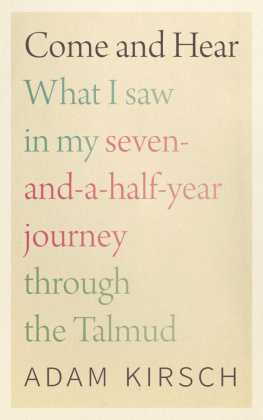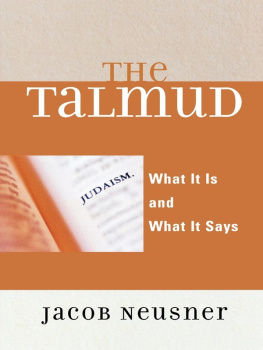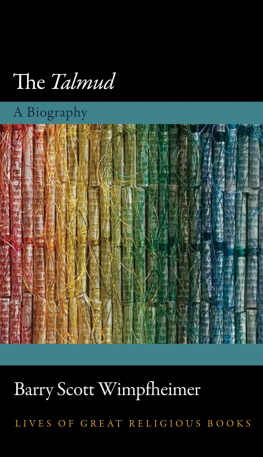Talya Fishman - Becoming the People of the Talmud
Here you can read online Talya Fishman - Becoming the People of the Talmud full text of the book (entire story) in english for free. Download pdf and epub, get meaning, cover and reviews about this ebook. year: 2018, genre: Romance novel. Description of the work, (preface) as well as reviews are available. Best literature library LitArk.com created for fans of good reading and offers a wide selection of genres:
Romance novel
Science fiction
Adventure
Detective
Science
History
Home and family
Prose
Art
Politics
Computer
Non-fiction
Religion
Business
Children
Humor
Choose a favorite category and find really read worthwhile books. Enjoy immersion in the world of imagination, feel the emotions of the characters or learn something new for yourself, make an fascinating discovery.
- Book:Becoming the People of the Talmud
- Author:
- Genre:
- Year:2018
- Rating:3 / 5
- Favourites:Add to favourites
- Your mark:
- 60
- 1
- 2
- 3
- 4
- 5
Becoming the People of the Talmud: summary, description and annotation
We offer to read an annotation, description, summary or preface (depends on what the author of the book "Becoming the People of the Talmud" wrote himself). If you haven't found the necessary information about the book — write in the comments, we will try to find it.
Becoming the People of the Talmud — read online for free the complete book (whole text) full work
Below is the text of the book, divided by pages. System saving the place of the last page read, allows you to conveniently read the book "Becoming the People of the Talmud" online for free, without having to search again every time where you left off. Put a bookmark, and you can go to the page where you finished reading at any time.
Font size:
Interval:
Bookmark:
Little is currently known about why the amoraim generated, and preserved, the traditions found in the Babylonian Talmud. What is clear is that Jews who lived in the centuries following the last of the Talmuds named tradents focused on the legal traditions of this orally transmitted corpus and, over time, transposed them so that they came to be construed as guidelines for living a Jewish life. A range of activities made this transposition possible: unclear words and phrases were explained, conflicting passages were harmonized, and adjudicatory principles, kelale pesiqa, were articulated. Principles of this sort, establishing (for example) that the law always accorded with Rabbi X whenever he disputed with Rabbi Y, functioned as algorithms; they helped to make unresolved data in the Babylonian Talmud usable in situations of applied law.
The saboraim, anonymous redactors of the sixth century, began the process of transposing Talmud into a usable corpus, but it is easier to speculate about the motives of those who continued this process through the mid-eleventh century, the Babylonian geonim. Rabbinic Jews of the post-talmudic era were spread throughout a vast geographic diaspora in communities shaped by dramatically disparate political, economic, and social circumstances. Working with the amoraic teachings that they had inherited, geonim embarked on a project to provide Jews throughout the world with a single and unifying legal system. The geonim undertook these labors in the environs of Baghdad, capital of the Abbasid caliphate, at a time and place where Muslim jurists and scholars of tradition were collecting, scrutinizing and systematizing inherited teachings so that the now far-flung community of Muslims, united by belief, could function and flourish as a single political entity, guided by clear legal norms.
Though the geonim advanced the process of transposing the Babylonian Talmud into a legal reference work, their own legal decisions continued to rely heavily on a non-talmudic source of authority, namely, lived tradition backed by trustworthy attestation. The comprehensive remodeling of Talmud as a legal reference work was only completed outside of the geonic academies, in Jewish communities of the eleventh and twelfth centuries. Whether through the use of bridging commentary (as was the case in Qayrawan, and later, Sefarad) or through the baring of intermediating operations of transposition (as was the case in the tosafist glosses of northern Europe), the Babylonian Talmuds legal material came to be portrayed and construed as applied law.
This study has linked the tosafization of the Babylonian Talmud to northern European Jewrys (relatively late) encounter with this corpus as a written text. It has suggested that the full-scale apprehension of Talmud as a prescriptive reference workand the range of bridge-building activities that made this apprehension possibleoccurred in this time and place for specific historical reasons. The textualization process that transformed the cultures of this region in the eleventh and twelfth centuries led resident populations to ascribe greater cultural authority to the written word than to mimetically transmitted teachings, and it motivated them to demonstrate that their own behaviors were guided by texts and aligned with them. The panoptic encounter with the written text of Talmud made it possible for readers to work with it in ways that were only possible when granted visual (and not solely auditory) access. These included a panoply of redactional, comparative, analytical, and harmonizing operations. In short, the change in the way that the Babylonian Talmud was transmitted affected that way that its traditions were perceived, understood, and used.
Other Cultural Shifts Linked to Changes
in the Transmission of Jewish Tradition
This conclusion (which can barely be mentioned without acknowledging Marshall McLuhans adage The medium is the message) brings to mind several other moments of cultural transition that were linked to modal changes in the transmission of Jewish tradition. The twelfth-century composition of the Mishneh Torah was one such instance, for, according to its critics, Jews of little training could now use Maimonides code to make legal decisions without consulting rabbinic authorities. Like observers of the textualization process described in this book who commented (neutrally or with nostalgia) on the decline of discipleship, observers of Jewish legal codification noted that cultural values had shifted, and that the prodigious mastery of tradition had come to carry less authority than had previously been the case. Once tradition was encountered in a different venue than had previously been the casewhether in writing, or in codificatory formexisting configurations of cultural, political, and social power were destabilized and, in some cases, redrawn.
Another comparable development was the consignment of Jewish traditions to print. If the medieval inscription of Talmud had made it difficult for rabbinic elites to control the role that this corpus of oral matters played vis--vis other sources of cultural authority, the problem was greatly exacerbated by the use of early modern technology. Print granted all readers who were literate in Hebrew access to both written and oral matters, and it placed particular bodies of knowledge squarely in the public domain. A Christian reader could now mine the Zohar to abet his conversionary agenda,
The standardization of Jewish traditions brought about by print also had the effect of narrowing readers perceptions of the Jewish past. Just as reliance on the inscribed Talmud marginalized extra-talmudic traditions, the early modern printing of Jewish works necessarily represented only a chosen sliver of the historical archive, and in this sense created a new canon, as El anan Reiner has shown in his research.
A third historical development that shares some features with the instance of textualization examined in this book was the subject of Haym Soloveitchiks justly famous essay, Rupture and Reconstruction: The Transformation of Contemporary Orthodoxy. Beginning in the second half of the twentieth century, noted Soloveitchik, observant American Jews came to ascribe greater authority to written texts than to living repositories of tradition. Nourished by geographic dislocation following the Holocaust, he suggested, this shift in mentalit was indicative of a lack of confidence in (human) religious authority. Rupture and Reconstruction situated this contemporary instance of preferring the written word to modeled behavior within the diachronic context of earlier reassessments of the locus of Jewish cultural authority. Not unlike the comments of the Shneur brothers of thirteenth-century Evreux,
Other Indices of Packaging and Their
Impact on Jewish Traditions
Awareness that shifts in modes of transmission have enormous impact on shaping the relayed content is not new in the study of classical rabbinic literature. Scholars of rabbinics, for example, have long understood that oral transmission made the corpora in question prone to specific types of change. Writing about the Mishnah, Saul Lieberman spoke of the fusion and confusion of the lemmata with the commenting text, ) about how the deeds of Rhenish Jews in 1096 are to be interpreted hinges on the question of whether the Jews of this time and place assigned equal, or unequal, cultural weight to units of halakhah and aggadah.
Along with the above-mentioned indicesoral versus written, and the taxonomic designation of a tradition as halakhah or aggadaha broad array of rabbinically generated rules that regulate the packaging of Jewish knowledge tag the relayed content with a specific cultural meaning or cultural worth. This is as clear in the ancient rabbis likening of certain compositions to a mere epistle as it is in the geonic assertion that Jews need not rely on aggadah. There are rules regulating variables such as the type of Hebrew font to be used; the material formate.g., scroll or codexto be employed for the inscription of the work in question; the use of parchment or of paper; the question of whether pricking and ruling needed to precede the writing of a particular text; the designation of certain written works as texts that defile the hands (that impart ritual impurity when touched); and the question of whether, or how, the text in question was to be preserved. Each rule articulated by rabbinic scholars for the transmission or treatment of a specific type of Jewish knowledge encoded a message about the cultural significance of the datum in question.
Font size:
Interval:
Bookmark:
Similar books «Becoming the People of the Talmud»
Look at similar books to Becoming the People of the Talmud. We have selected literature similar in name and meaning in the hope of providing readers with more options to find new, interesting, not yet read works.
Discussion, reviews of the book Becoming the People of the Talmud and just readers' own opinions. Leave your comments, write what you think about the work, its meaning or the main characters. Specify what exactly you liked and what you didn't like, and why you think so.











